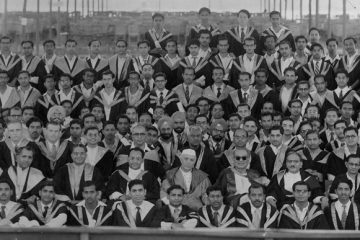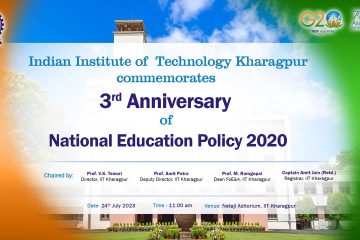
An AI-based intelligent traffic control system could revolutionize traffic management in India. Already, the Delhi Traffic Police are mulling over the matter. At IIT Kharagpur, an undergraduate student team -Bits n Bytes – presented an exhaustive model of such an AI system based on real time traffic feed and lifted the top prize at the up.AI Challenge recently.
The up.AI Challenge is what can be called the ‘endgame’ of the up.AI summit that was held at the IIT Kharagpur campus last October (http://www.kgpchronicle.iitkgp.ac.in/eat-pray-love-artificial-intelligence/). After a week-long jamboree in 2018 that saw a congregation of close to a thousand students, various faculty members and industry experts to talk and think about the application of Artificial Intelligence in various sectors, the up.AI Challenge was launched. Under the mentorship of IIT Kharagpur professors, students were to work on projects during the winter vacation and then present their conclusions to the judges.
 They did this summer. And the result was the winning idea of Bits n Bytes, followed by the projects of team EduFYI and TinTEd-AI which won the 1st runner-up and 2nd runner-up prizes respectively. EduFYI proposed an AI tool to automatically guide its users through a distance learning course, helping them to learn faster and more efficiently. TinT-AI proposed an AI-based Intelligent Automated Software Applications (iASA) to replace the prevalent ASA or Applicant Tracking Systems in the recruitment industry.
They did this summer. And the result was the winning idea of Bits n Bytes, followed by the projects of team EduFYI and TinTEd-AI which won the 1st runner-up and 2nd runner-up prizes respectively. EduFYI proposed an AI tool to automatically guide its users through a distance learning course, helping them to learn faster and more efficiently. TinT-AI proposed an AI-based Intelligent Automated Software Applications (iASA) to replace the prevalent ASA or Applicant Tracking Systems in the recruitment industry.
The intelligent traffic control system devised by Y. Sai Sanjeet, P. Anusha and P.V.S.L Hari Chandana of the winning team uses a deep reinforcement learning architecture to dynamically adjust traffic signals’ duration using a Deep Q network. The idea is to reduce the waiting time of vehicles at traffic intersections and allow a smooth flow of traffic.
 Hari Chandana says, “Compared to the existing approaches that focus on traffic signal optimization for a single intersection, our approach is based on a collaborative control of traffic signal phases of multiple intersections.” As the model uses Independent Q-Learning, it takes all the other intersections as part of the environment and gets to train on a wider sample of data.
Hari Chandana says, “Compared to the existing approaches that focus on traffic signal optimization for a single intersection, our approach is based on a collaborative control of traffic signal phases of multiple intersections.” As the model uses Independent Q-Learning, it takes all the other intersections as part of the environment and gets to train on a wider sample of data.
 The model, the team says, is adaptable and can be used to control traffic in any area, by simulating the road network and training the model on it. The model can then be used to intelligently control the real-time traffic in that particular road network.
The model, the team says, is adaptable and can be used to control traffic in any area, by simulating the road network and training the model on it. The model can then be used to intelligently control the real-time traffic in that particular road network.
Like Bits n Bytes, EduFYI also tackles a relevant problem. In online distance learning courses, it often becomes difficult for instructors to answer individual doubts and questions. With classification of these questions into educational categories, the instructor can hope to better address student queries. At the same time, students can get a better evaluation of their understanding of the study material.
 Divyansh, who was guided by Prof. Jiaul Paik, says, “For our task, we decided to classify the questions based on Bloom’s taxonomy.” The project termed “ConvNets with BiLSTMs for Question Category classification using ELMo Embeddings” has led to a model that has showed 80 per cent test accuracy and, it is hoped, will improve personalized learning such as in the online MOOC sector.
Divyansh, who was guided by Prof. Jiaul Paik, says, “For our task, we decided to classify the questions based on Bloom’s taxonomy.” The project termed “ConvNets with BiLSTMs for Question Category classification using ELMo Embeddings” has led to a model that has showed 80 per cent test accuracy and, it is hoped, will improve personalized learning such as in the online MOOC sector.
TintEd-AI hopes to help job-seekers to get hired and recruiters to hire using AI. The lone member team of Kumar Aniket was mentored by Arindam Chatterjee of HSBC Global Analytics, India, and Poornima Muthuswamy of Innovation Team Wells, Fargo, California.
 His ‘Tint’ has several components – Resume Job Matcher, Job Recommender System, Automatic Resume Summarizer based on NLP and Automatic Resume Scoring that takes into account not only how the resume scores across different fields of education and professional degrees but also word count per section such as experience, leadership, projects etc. Aniket says, “Strategic use of AI, combined with the personal touch of human recruiters can help companies fill open positions faster and with more qualified candidates.”
His ‘Tint’ has several components – Resume Job Matcher, Job Recommender System, Automatic Resume Summarizer based on NLP and Automatic Resume Scoring that takes into account not only how the resume scores across different fields of education and professional degrees but also word count per section such as experience, leadership, projects etc. Aniket says, “Strategic use of AI, combined with the personal touch of human recruiters can help companies fill open positions faster and with more qualified candidates.”
Anirban Santra, a PhD student of the Computer Science and Engineering Department, who was the Program Chair of up.AI said, “Several of the ideas presented at the up.AI Challenge may have been visited before. But what is important is that undergraduate students took up the challenge to use AI to come up with solutions and learnt a lot in the process.”
 Many of the participants have plans to further develop their ideas. Kumar Aniket, for example, wants to develop a Virtual Interview Analyzer. Prof. Sudeshna Sarkar, Head of the CoE for AI, said, “Up.AI tapped into the massive interest of students in AI. I hope that in the coming days, they will develop their interests and come up with more robust solutions using AI.”
Many of the participants have plans to further develop their ideas. Kumar Aniket, for example, wants to develop a Virtual Interview Analyzer. Prof. Sudeshna Sarkar, Head of the CoE for AI, said, “Up.AI tapped into the massive interest of students in AI. I hope that in the coming days, they will develop their interests and come up with more robust solutions using AI.”
Graphics : Suman Sutradhar
Graphics : Suman Sutradhar



